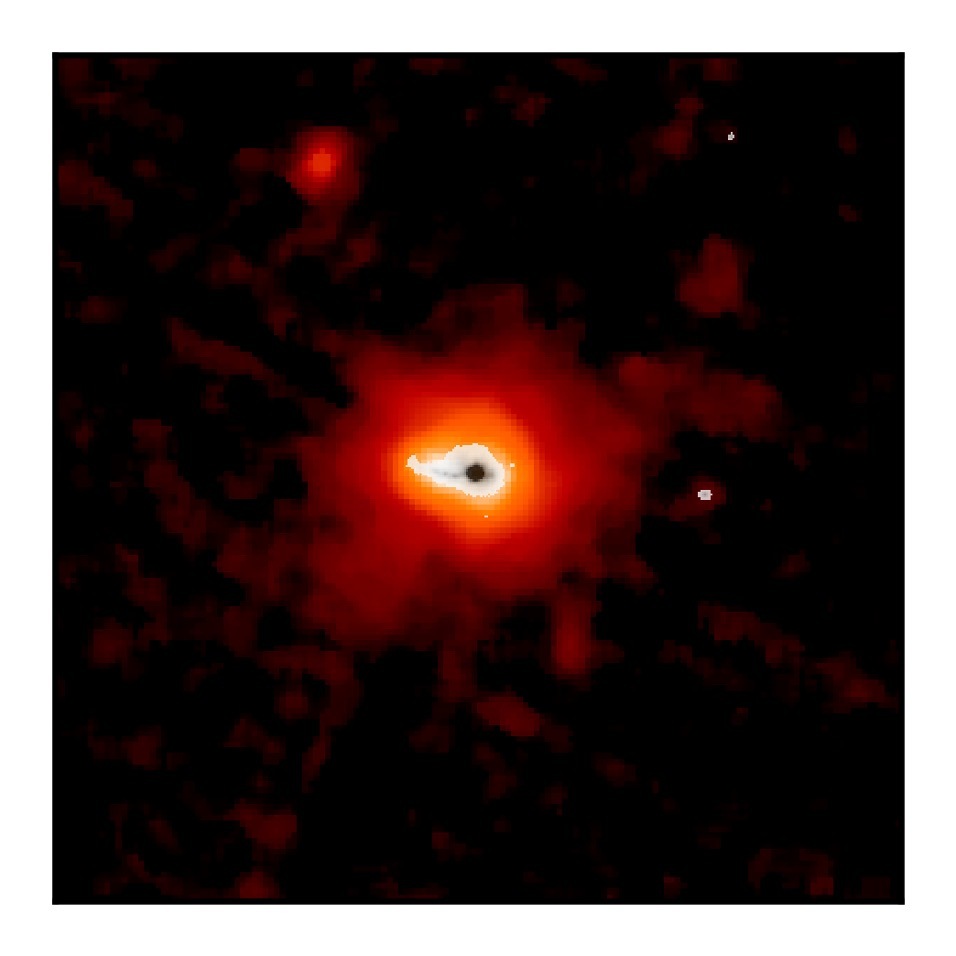5.09.2025
Astronomer Sylvain Veilleux helped to detect dust far outside the body of a galaxy in a reservoir of hot gas, raising questions about how these particles survived such a long and volatile journey.

In the center of this image, the Makani galaxy is shown in black surrounded by a fainter emission in white. Beyond that, warm dust is shown in red, with the most far-flung particles detected at a distance of 114,000 light-years from the galaxy's center. Image courtesy of Sylvain Veilleux and Steven D. Shockley based on NASA/JWST data.
In a distant galaxy called Makani, particles of dust were warmed by the light of newborn stars before being flung out into space by a massive starburst-driven wind. Over the course of 100 million years, the dust traveled farther and farther from Makani’s center, ultimately ending up in the reservoir of hot gas that surrounds a galaxy, known as the circumgalactic medium (CGM).
A research team led by University of Maryland Astronomy Professor Sylvain Veilleux used the James Webb Space Telescope (JWST) to study these resilient dust particles, marking the first time that a dust infrared emission has been directly observed at such a great distance. Their study, published in The Astrophysical Journal on August 25, 2025, could help researchers understand how outflows of gas and dust affect the evolution of galaxies.
“Overall, these results provide the strongest evidence so far that the ejected dust of galactic winds may survive the long journey to the CGM,” Veilleux said. “Before this study, there had not been a direct detection of dust on such a large scale, and Webb was the key that made it happen.”
JWST’s sensitivity makes it well-equipped to detect space dust—especially warm dust, which glows brightly in the infrared wavelength. Astronomers set their sights on Makani, which means “wind” in Hawaiian, because it underwent a period of intense star formation that produced a strong galactic wind that carried gas and dust with it. In 2019, David Rupke (Ph.D. ’04, physics) led a study of Makani that found the first direct evidence that galactic winds play a significant role in creating the CGM.
The 2019 study focused primarily on outflows of gas, but Veilleux and his co-authors wanted to understand what was happening to the dust in the galactic wind. Though these galactic dust particles are microscopic, they are an important ingredient in the formation of planets and stars. Studying how gas and dust cycle in and out of a galaxy can offer clues about how galaxies change over time.
“Each galaxy is surrounded by a halo of gas, with gas coming in and gas going out,” Veilleux explained. “Understanding this gas cycle has become one of the hottest topics in galaxy evolution studies because we now know that it's a really important consideration.”
In the case of the Makani galaxy, Veilleux and his co-authors discovered that dust particles degraded along their windswept journey to the CGM but did not fully disintegrate, raising questions about how the dust was able to survive. While trapped in this galactic wind, dust particles would have been surrounded by hot gases exceeding 10,000 Kelvin—more than 17,000 degrees Fahrenheit.
“If dust touches gas at 10,000 degrees, it's going to vaporize it. It shouldn't survive,” Veilleux said. “We think that somehow it's been shielded or protected from the hotter gas—probably by cooler clumps of gas that protect the dust in a cocoon.”
To take their findings a step further, Veilleux and his colleagues plan to conduct a follow-up study that will use JWST to take a spectrum, or “fingerprint,” of the dust in this region. This data will help to paint a more detailed picture of the dust’s distinct properties, including the size of each dust particle.
In the long term, Veilleux would like to push the boundaries even further by potentially detecting dust on larger scales, including the spaces that exist between galaxies, known as the intergalactic medium. If dust could travel that far, it would represent a journey of a million light-years or more.
“The next question is, ‘Can we ever detect dust in the intergalactic medium?’” Veilleux said. “That would be very exciting because it would mean that the full cycle is closed—that dust is not only in the halo of the galaxy, but even beyond that.”
More broadly, Veilleux hopes that studies like these can help astronomers see not just what galaxies looked like in the distant past, but also where they’re headed next.
“From the Big Bang to today, galaxies are living beasts in a way,” Veilleux said. “They’re still evolving, and that cycle of gas in and out is important in knowing what will happen in the future.”
Quelle: The College of Computer, Mathematical, and Natural Sciences at the University of Maryland
